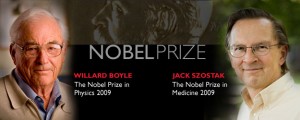 Back-to-back wins “remarkable,” Principal says
Back-to-back wins “remarkable,” Principal says
By Doug Sweet
One of them got into McGill in 1968 at the age of 15. Four years, two scholarships and a botany prize later, Jack Szostak had graduated with a BSc in biology. This week, he capped a remarkable academic career with the 2009 Nobel Prize in Medicine, shared with two other American researchers.
The other did a hitch in the air arm of Canadian Navy during the Second World War and then found his way to McGill. He did three degrees in succession – a BSc in 1947, an MSc in ’48 and a PhD in ’50. Three years later, Willard Boyle landed at the legendary Bell Laboratories in New Jersey, where he went on to share the discovery of a device that is the key component in digital photography. This week, at age 85, he was recognized for that groundbreaking work with the 2009 Nobel Prize in Physics.
At a stroke, the number of Nobels earned by McGill alumni rose by 50 per cent, to six.
“To have two of our graduates win shares of Nobel Prizes on consecutive days is indeed remarkable,” said Principal and Vice-Chancellor Heather Munroe-Blum. “I know I speak for the entire McGill community when I say that we are extremely proud of Dr. Boyle and Dr. Szostak and the advances they pioneered.”
Boyle, who is the retired Executive Director of Research at the Communications Sciences Division of Bell Laboratories, shares the prize with his Bell Laboratories collaborator George E. Smith, along with Charles K. Kao of the Standard Telecommunications Laboratory in Harlow, England, and the Chinese University of Hong Kong.
Boyle and Smith were awarded their share of the prize for the 1969 invention of the charged-couple device (CCD), a semiconductor circuit capable of sensing light and images, the core technology behind today’s digital photography revolution.
Szostak, who was born in London, England, but was raised in Montreal’s West Island, won a share of his prestigious prize for research that showed how organisms rely on a particular enzyme to protect themselves from losing genetic material during cell division. Later studies linked this enzyme to cancer and aging-related maladies. Normally the enzyme, telomerase, gradually shuts down as a body ages; when it runs amok, cancer can result.
Szostak, who went on to a PhD at Cornell, is an investigator with the Howard Hughes Medical Institute at Massachusetts General Hospital in Boston and Harvard Medical School. He shares the prize with Elizabeth Blackburn of the University of California, San Francisco, and Carol Greider of the Johns Hopkins University School of Medicine.
Howard Bussey, an Emeritus professor in Biology, knew Szostak as a graduate student and a post-doctoral fellow.
“It was always clear that he was pretty clever,” Bussey said. “I’m delighted to see that it all worked out for him.”
Szostak was, in fact, a brilliant student, who entered McGill at an impossibly young age and was awarded a McGill University Scholarship and the Walter W. Ross III Memorial Scholarship in 1971, as well as the Penhallow Prize in Botany in 1972.
He and Boyle four other McGill alumni who have been awarded a Nobel prize:
• Rudolph Marcus, BSc’43, PhD’46, received the 1992 Nobel Prize in Chemistry for his theory of electron transfer.
• David Hubel, BSc’47, MDCM’51, was co-recipient of the 1981 Nobel Prize in Medicine for his groundbreaking work on visual perception.
• American particle physicist Val Fitch, BEng’48, was co-recipient of the 1980 Nobel Prize in Physics for an experiment conducted in 1964 that disproved the long-held theory that particle interaction should be indifferent to the direction of time.
• Endocrinologist Andrew Victor Schally, BSc’55, PhD’59, DSc’79, was the co-recipient of the 1977 Nobel Prize for Medicine for his research on hormones.
